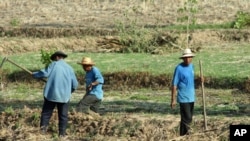A drought in Southeast Asia is threatening rice production in Cambodia and Thailand, the world's biggest rice exporter. The concern about production comes as rice prices have sunk to a two-year low, hurting farmers' incomes.
The lack of rain in Cambodia and Thailand cut rice production by as much as 40 percent. Farmers usually harvest one rice crop in August, and the main rice crop in October.
In Thailand, the government is concerned that farm irrigation will stretch already thin water supplies. Supavud Saicheua, managing director and head of research at Phatra Securities (PATRA), said the government has already asked farmers to delay the planting of the main crop.
"And that means that rice production, rice harvest, will bunch up in November. Now, if there's a sense globally that there's a lot of rice and the price is depressed even more, then Thai farmers will be hit in terms of both price and quantity," he said.
Supavud added while Thailand's economy as a whole has recovered from the global financial crisis and recent political turmoil, agriculture is still suffering.
Last month, rice prices in Thailand, Asia's benchmark, hit a two-year low after a drop in export demand. In response, Thai authorities adjusted a subsidy to offer a guaranteed price for rice farmers.
But Chanchai Rakthananon president of the Thai Rice Mills Association, said that move proved inadequate. The guaranteed price right now is just enough to meet farmers' costs, he said, because they are getting a low yield from the drought. Chanchai said that is affecting their income, so farmers are not making any profit.
Farm market analysts say rice prices should rise as markets feel the effects of the drought.
Chanchai said farmers are now planting more corn and sugar cane to cut their losses from the poor rice crop. But he added it will take a year or two to reclaim farmland for rice once prices recover. In the meantime, government stocks can make up for production shortages.
However, Thailand's rice exports, accounting for about a third of the world total, are expected to drop by up to a million tons this year, which could affect importing countries.
National Food Authority of the Philippines spokesman Rex Estoperez is a spokesman said the shortfall will definitely affext rice supplies for the Philippines, Asia's biggest rice importer.
"But, you know, Thailand is only one of the suppliers of the Philippines. And, over last year, we had our tender in December and our major supplier then was Vietnam," Estoperez said.
The Philippines buys rice from a total of six countries. As long as there are no more major weather calamities, Estoperez said they should not have a problem sourcing enough rice this year.
In 2008, poor weather and low rice stocks led to prices skyrocketing to over $1,000 a ton. Exporting countries put restrictions on overseas rice sales.
United Nations Food and Agriculture Organization senior economist Concepcion Calpe said while drought has lowered Cambodia's expected rice production about 10 percent and Thailand's by about six percent, Asia's crop as a whole will be better than 2009.
"Indonesia, even though they had a bad start and were also affected by drought, they still will record an increase," Calpe said. "India, we foresee a very strong recovery from last year … because it was affected by the erratic monsoon. China we see will increase tremendously their production, Bangladesh also. So, the major players, so far we see that they will have a larger crop in 2010."
With production up and plenty of rice in government reserves, said Calpe, there is little risk of food shortages or price jumps.
But she also pointed out that the drought affecting Cambodia and Thailand may cause more hardship for small producers, urging rice farmers to diversify their crops so they are not so dependent on one product.
Drought Threatens Cambodia, Thailand Rice Output






